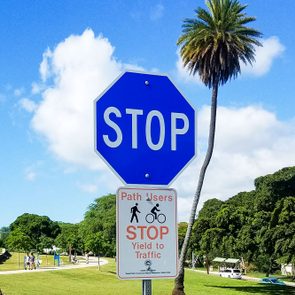Red lights are for fire trucks, and blue means law enforcement. But what about green lights on a car? We have the answer.

Here’s What It Means If You See Green Lights on a Car

If you’ve ever been pulled over, you know the sinking feeling in your stomach when you see those red-and-blue flashing lights. You ease up on the gas, silently praying that the police car will pass by on the way to the real emergency that has nothing to do with you going 8 miles over the speed limit. But what if your rearview mirror reveals green lights on a car behind you? They’re not as common as your typical emergency vehicle lights, but you could definitely see them on the road—and it’s important to know what they’re trying to tell you.
Believe it or not, there’s not a lot of readily available information on the internet about this. (Who would’ve thought?!) To get to the bottom of this mystery and learn some interesting facts about various car-light colors, Reader’s Digest spoke with William Van Tassel, PhD, manager of driver training programs at the American Automobile Association (AAA), and Kevin Feak, a licensed fire protection engineer who holds certifications in emergency management, infrastructure protection and codes enforcement.
Ahead, we’ll explain what green lights on a car could mean and why you should take them seriously.
Get Reader’s Digest’s Read Up newsletter for more interesting facts, humor, cleaning, travel and tech all week long.
What do green lights on a car mean?
It depends. “The use of green lights on vehicles varies from state to state,” Feak says. “Each state regulates the use of colored lights on vehicles,” so while you immediately recognize red and blue flashing lights, green lights can be confusing if you’ve never seen them.
Green lights on a car could mean the vehicle is from a federal agency—in particular, Homeland Security. “But they also can be used locally for state departments of transportation, volunteer firefighters, emergency medical technicians (EMTs) and even law enforcement vehicles that are involved in emergency crowd control,” Van Tassel says. Bucking the trend, Michigan uses green lights on road-maintenance vehicles and snowplows. “So it varies quite a bit,” Van Tassel notes.
However, green lights, like their relatives red and blue, are generally ways to communicate that an official needs to get through to an ongoing traffic situation. “Basically, it’s a situation where another vehicle is seeking to have a priority on the road,” Van Tassel says. “A good default is to interpret a flashing green light as a vehicle responding to some form of emergency.”
“Green lights can also identify a command vehicle on an emergency scene,” Feak says. “This unique color allows responders to quickly see where the incident commander is located. In this instance, the green lights are used as an auxiliary color to the main red or blue emergency lights adopted by a jurisdiction.”

Can you put green lights on your car?
Not typically, but laws about putting green lights on a personal or privately owned vehicle vary from state to state.
- In Indiana, privately owned vehicles operated by volunteer firefighters, EMTs, paramedics and other emergency responders in the line of duty can use flashing or revolving green lights, but anyone else is guilty of a Class C infraction, a minor offense similar to a speeding ticket.
- Connecticut allows volunteer ambulance associations to use green flashing lights, while in Texas, green lights are reserved for private security guards. Violating these statutes will net you a $90 fine in Connecticut and from $50 to $200 dollars in Texas, where penalties are not specifically codified.
- New York also allows volunteer ambulances to use green lights and recently amended the law to include mental health professionals responding to a crisis. Penalties are similar to a traffic ticket.
So your ability to put green lights on a car is limited, and in many states, it’s not just bad driving etiquette—it’s illegal. Before modifying your car, look up your state’s motor vehicle laws online, or call your state department of motor vehicles. Otherwise, the next lights you see might be red and blue.
What other emergency lights might you see on cars?
Emergency vehicle lights make good use of the color spectrum, which helps civilian drivers stay alert to possible emergencies. “Each state regulates the use of colored lights on vehicles,” Feak says. “A factor in the selection of emergency light colors is the visibility during day, night and inclement weather conditions.”
In addition to green flashing lights on a car, you’re likely to come across the colors below.
Red lights
In jurisdictions across the country, red lights are emergency vehicle lights: police, fire or emergency medical services such as ambulances. It makes sense, because red signals stop—think: stop signs and, of course, taillights. When you see red lights, it’s a cue for you to pay attention and potentially take action.
Red isn’t confined to police and fire, though. In Iowa, leaders of funeral processions can use red and amber lights (more on those below). And in Texas, you could see red lights—alone or in combination with other colors—on tow trucks, medical examiner vehicles and cars driven by justices of the peace.
Red lights can be solid or flashing, and they can also be found on the top, front and back of school buses to remind you to watch for children.
Blue lights
Some countries have blue traffic lights, but in the United States, blue is most commonly associated with law enforcement, though that’s not always the case. “For example, a vehicle with a blue flashing light in New York State identifies a volunteer firefighter, while the same blue flashing light in Pennsylvania is used for law enforcement,” Feak says.
There are a few states in which law enforcement vehicles use blue lights only, such as Arkansas, but blue often appears alongside other colors.
White lights
Headlights are the most common white lights on the road, but you can also catch them flashing on an emergency vehicle roof or as part of a light bar. White lights provide contrast to other colored lights that can get lost in a sea of red taillights, especially in traffic. Using white lights next to red makes it easier for drivers to pick out an emergency vehicle.
Additionally, you might see flashing white lights on school buses, postal delivery trucks and other government vehicles, as well as on vehicles that service trains and railroads (such as fueling trucks).
Amber lights
Amber lights often appear on slow-moving vehicles or vehicles that stop frequently, like wide-load tractor trailers, garbage trucks, snowplows and postal vehicles. Minnesota requires snowplows to have alternating red and amber lights, and as we saw earlier, in Iowa you’ll find amber lights on vehicles leading funeral processions. When you see amber lights, it’s polite—and definitely safer—to slow down and give the vehicle room when you can.
Purple lights
Purple lights are more uncommon than other vehicle lights, but if you see them, they will almost always be leading a funeral procession. Hearses or lead vehicles in New Hampshire must have a purple flashing or emergency light, while Missouri and West Virginia can have purple or amber lights.
Additional reporting by Ally Childress.
Next, find out the reason for a bright orange sticker slapped across the front windshield or rear window of a vehicle.
About the experts
|
Why trust us
At Reader’s Digest, we’re committed to producing high-quality content by writers with expertise and experience in their field in consultation with relevant, qualified experts. We rely on reputable primary sources, including government and professional organizations and academic institutions as well as our writers’ personal experiences where appropriate. For this piece on green lights on a car, Chloë Nannestad tapped her experience as a journalist who covers interesting facts and trivia for Reader’s Digest. We verify all facts and data, back them with credible sourcing and revisit them over time to ensure they remain accurate and up to date. Read more about our team, our contributors and our editorial policies.
Sources:
- Kevin Feak, senior fire protection engineer at LaBella Associates; email interview, Feb. 26, 2025
- William Van Tassel, PhD, manager of driver training at the American Automobile Association (AAA); phone interview, Feb. 13, 2025
- Connecticut General Assembly: “Right-of-Way of Funeral Processions”
- Indiana Volunteer Firefighters Association: “Green Light Law”
- Justia: “Arkansas Code of 1987 (2024)”
- Justia: “2024 Connecticut General Statutes”
- Michigan Department of Transportation: “Green Lights on Snowplows”
- Minnesota Legislature: “2024 Minnesota Statutes”
- New York State Senate: “Senate Bill S5397”
- Texas Department of Public Safety: “Red, White or Blue Lights”
- Texas Department of Transportation: “Lighting Standards for Highway Maintenance or Construction Vehicles and Service Vehicles”
- U.S. Department of Justice: “Law Enforcement Vehicle Lighting and Reflectivity Studies: An Overview”






















